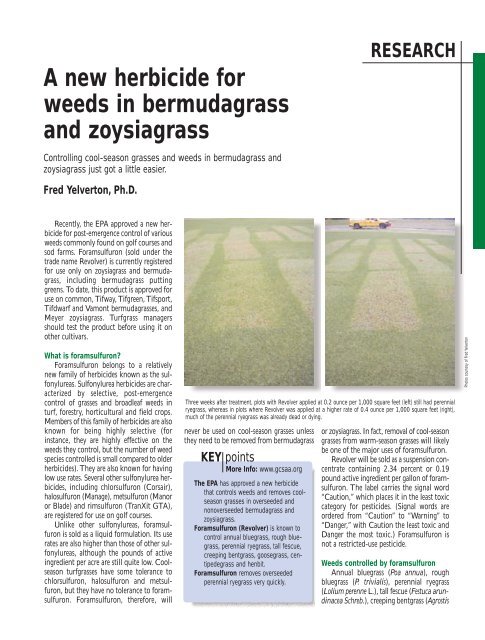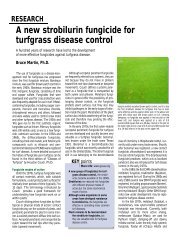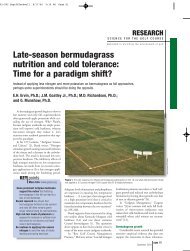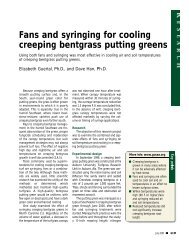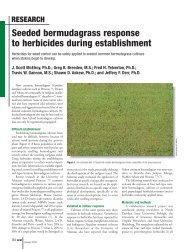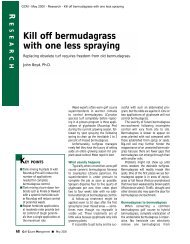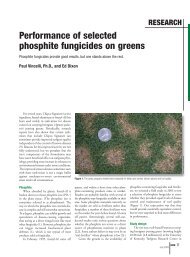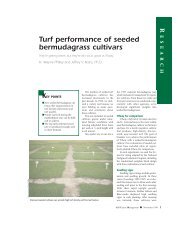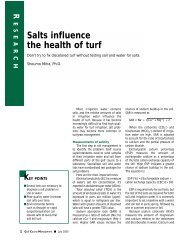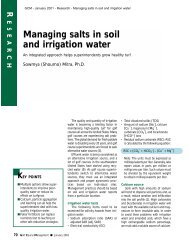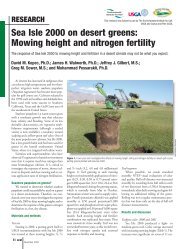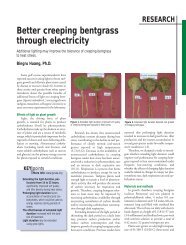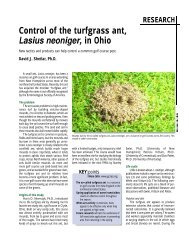A new herbicide for weeds in bermudagrass and zoysiagrass - GCSAA
A new herbicide for weeds in bermudagrass and zoysiagrass - GCSAA
A new herbicide for weeds in bermudagrass and zoysiagrass - GCSAA
Create successful ePaper yourself
Turn your PDF publications into a flip-book with our unique Google optimized e-Paper software.
A <strong>new</strong> <strong>herbicide</strong> <strong>for</strong><strong>weeds</strong> <strong>in</strong> <strong>bermudagrass</strong><strong>and</strong> <strong>zoysiagrass</strong>RESEARCHControll<strong>in</strong>g cool-season grasses <strong>and</strong> <strong>weeds</strong> <strong>in</strong> <strong>bermudagrass</strong> <strong>and</strong><strong>zoysiagrass</strong> just got a little easier.Fred Yelverton, Ph.D.Recently, the EPA approved a <strong>new</strong> <strong>herbicide</strong><strong>for</strong> post-emergence control of various<strong>weeds</strong> commonly found on golf courses <strong>and</strong>sod farms. Foramsulfuron (sold under thetrade name Revolver) is currently registered<strong>for</strong> use only on <strong>zoysiagrass</strong> <strong>and</strong> <strong>bermudagrass</strong>,<strong>in</strong>clud<strong>in</strong>g <strong>bermudagrass</strong> putt<strong>in</strong>ggreens. To date, this product is approved <strong>for</strong>use on common, Tifway, Tifgreen, Tifsport,Tifdwarf <strong>and</strong> Vamont <strong>bermudagrass</strong>es, <strong>and</strong>Meyer <strong>zoysiagrass</strong>. Turfgrass managersshould test the product be<strong>for</strong>e us<strong>in</strong>g it onother cultivars.What is <strong>for</strong>amsulfuron?Foramsulfuron belongs to a relatively<strong>new</strong> family of <strong>herbicide</strong>s known as the sulfonylureas.Sulfonylurea <strong>herbicide</strong>s are characterizedby selective, post-emergencecontrol of grasses <strong>and</strong> broadleaf <strong>weeds</strong> <strong>in</strong>turf, <strong>for</strong>estry, horticultural <strong>and</strong> field crops.Members of this family of <strong>herbicide</strong>s are alsoknown <strong>for</strong> be<strong>in</strong>g highly selective (<strong>for</strong><strong>in</strong>stance, they are highly effective on the<strong>weeds</strong> they control, but the number of <strong>weeds</strong>pecies controlled is small compared to older<strong>herbicide</strong>s). They are also known <strong>for</strong> hav<strong>in</strong>glow use rates. Several other sulfonylurea <strong>herbicide</strong>s,<strong>in</strong>clud<strong>in</strong>g chlorsulfuron (Corsair),halosulfuron (Manage), metsulfuron (Manoror Blade) <strong>and</strong> rimsulfuron (TranXit GTA),are registered <strong>for</strong> use on golf courses.Unlike other sulfonylureas, <strong>for</strong>amsulfuronis sold as a liquid <strong>for</strong>mulation. Its userates are also higher than those of other sulfonylureas,although the pounds of active<strong>in</strong>gredient per acre are still quite low. Coolseasonturfgrasses have some tolerance tochlorsulfuron, halosulfuron <strong>and</strong> metsulfuron,but they have no tolerance to <strong>for</strong>amsulfuron.Foramsulfuron, there<strong>for</strong>e, willThree weeks after treatment, plots with Revolver applied at 0.2 ounce per 1,000 square feet (left) still had perennialryegrass, whereas <strong>in</strong> plots where Revolver was applied at a higher rate of 0.4 ounce per 1,000 square feet (right),much of the perennial ryegrass was already dead or dy<strong>in</strong>g.never be used on cool-season grasses unlessthey need to be removed from <strong>bermudagrass</strong>KEY po<strong>in</strong>tsMore Info: www.gcsaa.orgThe EPA has approved a <strong>new</strong> <strong>herbicide</strong>that controls <strong>weeds</strong> <strong>and</strong> removes coolseasongrasses <strong>in</strong> overseeded <strong>and</strong>nonoverseeded <strong>bermudagrass</strong> <strong>and</strong><strong>zoysiagrass</strong>.Foramsulfuron (Revolver) is known tocontrol annual bluegrass, rough bluegrass,perennial ryegrass, tall fescue,creep<strong>in</strong>g bentgrass, goosegrass, centipedegrass<strong>and</strong> henbit.Foramsulfuron removes overseededperennial ryegrass very quickly.or <strong>zoysiagrass</strong>. In fact, removal of cool-seasongrasses from warm-season grasses will likelybe one of the major uses of <strong>for</strong>amsulfuron.Revolver will be sold as a suspension concentrateconta<strong>in</strong><strong>in</strong>g 2.34 percent or 0.19pound active <strong>in</strong>gredient per gallon of <strong>for</strong>amsulfuron.The label carries the signal word“Caution,” which places it <strong>in</strong> the least toxiccategory <strong>for</strong> pesticides. (Signal words areordered from “Caution” to “Warn<strong>in</strong>g” to“Danger,” with Caution the least toxic <strong>and</strong>Danger the most toxic.) Foramsulfuron isnot a restricted-use pesticide.Weeds controlled by <strong>for</strong>amsulfuronAnnual bluegrass (Poa annua), roughbluegrass (P. trivialis), perennial ryegrass(Lolium perenne L.), tall fescue (Festuca arund<strong>in</strong>aceaSchreb.), creep<strong>in</strong>g bentgrass (AgrostisPhotos courtesy of Fred Yelverton
RESEARCHstolonifera) <strong>and</strong> other cool-season grasses arecontrolled by <strong>for</strong>amsulfuron, as are goosegrass,centipedegrass <strong>and</strong> henbit. Because<strong>for</strong>amsulfuron is <strong>new</strong>, the complete spectrumof <strong>weeds</strong> controlled is not yet known.However, research has shown that the abovementionedspecies are effectively controlled.The rates will range from 0.1 to 0.6ounce/1,000 square feet or 4.4 to 26.2ounces/acre.It is recommended that <strong>for</strong>amsulfuron beapplied <strong>in</strong> at least 25 but not more than 60gallons of water per acre. If the pH of thespray solution is less than 6, a buffer<strong>in</strong>g agentis recommended. As with any <strong>herbicide</strong>, certa<strong>in</strong>precautions should be followed. The follow<strong>in</strong>gare the most notable:• Apply to actively grow<strong>in</strong>g <strong>weeds</strong>. WeedsFORAMSULFURON VS. WEEDSunder stress (drought, etc.) will not be controlledeffectively.• Ra<strong>in</strong>fall with<strong>in</strong> two hours after applicationmay reduce control.• Do not use more than 1.25 ounces/1,000square feet (54.5 ounces/acre) per season.• Apply <strong>for</strong>amsulfuron with<strong>in</strong> 24 hours ofmix<strong>in</strong>g.• Do not apply <strong>for</strong>amsulfuron with<strong>in</strong> twoweeks of <strong>bermudagrass</strong> sprigg<strong>in</strong>g.• Do not apply <strong>for</strong>amsulfuron with<strong>in</strong> twoweeks be<strong>for</strong>e overseed<strong>in</strong>g bermudgrasswith cool-season grasses.• Avoid excessive aerification <strong>and</strong> verticutt<strong>in</strong>gwith<strong>in</strong> one week of application.• Do not use on residential turf.• Do not collect grass clipp<strong>in</strong>gs <strong>for</strong> mulchor compost.Application rate*Species controlled Ounce/1,000 square feet Ounces/acrePerennial ryegrass 0.2, 0.4 8.8, 17.4Volunteer perennial ryegrass,tall fescue & other cool-season grasses 0.2, 0.4, 0.6 8.8, 17.4, 26.2Poa annua 0.2, 0.4 8.8, 17.4Poa trivialis, P. annua, & creep<strong>in</strong>gbentgrass <strong>in</strong> overseeded <strong>bermudagrass</strong>greens, tees, collars & approaches 0.1, 0.2, 0.4 4.4, 8.8, 17.4Goosegrass 0.4, 0.6 17.4, 26.2Centipedegrass 0.6 26.2Henbit 0.4 17.4*Multiple applications may be required <strong>for</strong> goosegrass, volunteer perennial ryegrass or where the rate of 0.1ounce/1,000 square feet rate is used. For goosegrass, two applications spaced seven to 14 days apart are recommended.The lower rate may be used <strong>for</strong> goosegrass <strong>in</strong> the one- to three-leaf stage, but the higher rateshould be used on goosegrass with one to three tillers.Research with <strong>for</strong>amsulfuronUniversity researchers have tested <strong>for</strong>amsulfuron<strong>for</strong> the past three years. Theremoval of perennial ryegrass (<strong>and</strong> otheroverseeded cool-season grasses) from<strong>bermudagrass</strong> has been <strong>in</strong>vestigated extensively,<strong>and</strong> there is little doubt that <strong>for</strong>amsulfuronwill be effective <strong>for</strong> this use. Thedata shown here are representative of threeyears of research at multiple locations.Remov<strong>in</strong>g perennial ryegrassIn a test conducted at PrestonwoodCountry Club <strong>in</strong> Cary, N.C., <strong>for</strong>amsulfuronwas very effective <strong>in</strong> remov<strong>in</strong>g perennial ryegrassfrom a fairway. Foramsulfuron appliedat 0.4 or 0.6 ounce/1,000 square feet essentiallyremoved the perennial ryegrass <strong>in</strong> fourweeks (86 <strong>and</strong> 89 percent control, respectively).In this test, the lowest rate of <strong>for</strong>amsulfuronwas not effective <strong>in</strong> remov<strong>in</strong>gperennial ryegrass.Metsulfuron (Manor) was effective <strong>in</strong>remov<strong>in</strong>g perennial ryegrass <strong>and</strong> is considereda st<strong>and</strong>ard treatment <strong>for</strong> this purpose,but, as the data <strong>in</strong>dicate, metsulfuron did notact as quickly as <strong>for</strong>amsulfuron to killperennial ryegrass. Note that as early as threeweeks after treatment (when these pictureswere taken), the perennial ryegrass <strong>in</strong> <strong>for</strong>amsulfuron-treatedplots looked dead. The onlyturf visible <strong>in</strong> these pictures is the underly<strong>in</strong>g<strong>bermudagrass</strong>.Speed of controlIn general terms, the speed at which <strong>herbicide</strong>scontrol perennial ryegrass is not considereda negative or a positive. Individualsuper<strong>in</strong>tendents need to determ<strong>in</strong>e the speedat which they want to control perennial rye-REMOVAL OF PERENNIAL RYEGRASSRate% perennial ryegrass controlTreatment (ounce/1,000 square feet) (ounces/acre) 2 WAT 4 WAT 8 WATForamsulfuron 0.2 9 49 23 60Foramsulfuron 0.4 18 58 86 100Foramsulfuron 0.6 28 55 89 100Metsulfuron 0.01 0.5 50 40 85WAT = weeks after treatment.Removal of perennial ryegrass from an overseeded <strong>bermudagrass</strong> fairway at Prestonwood CC, Cary, N.C., 2001. Applications were made May 7, 2001. Mow<strong>in</strong>g height was0.5 <strong>in</strong>ch. A nonionic surfactant at 0.25 percent volume/volume was added to metsulfuron.
RESEARCHPoa annuaIn nonoverseeded <strong>bermudagrass</strong>, <strong>for</strong>amsulfuroncan also be used to control annual bluegrass(P. annua). Annual bluegrass control <strong>in</strong>nonoverseeded <strong>bermudagrass</strong> can be difficult <strong>in</strong>areas where <strong>bermudagrass</strong> does not go completelydormant. Where <strong>bermudagrass</strong> does gocompletely dormant, glyphosate (Roundup,etc.) can be used <strong>for</strong> annual bluegrass control,but it cannot be used <strong>in</strong> areas that fail to go dormant.There<strong>for</strong>e, <strong>for</strong>amsulfuron can be an effectivemanagement tool <strong>for</strong> golf coursesuper<strong>in</strong>tendents who cannot use glyphosate.Foramsulfuron removed annual bluegrasseffectively, but it took approximately 10weeks to get complete control. Foramsulfuronwas as effective as glyphosate <strong>in</strong> remov<strong>in</strong>gannual bluegrass from <strong>bermudagrass</strong>.SummaryIn summary, <strong>for</strong>amsulfuron will be an additionaltool <strong>for</strong> the management of certa<strong>in</strong> <strong>weeds</strong><strong>for</strong> turfgrass managers with <strong>bermudagrass</strong> <strong>and</strong>zoysia. It is highly toxic to cool-season turfgrassspecies <strong>and</strong>, there<strong>for</strong>e, will be an effective tool <strong>for</strong>remov<strong>in</strong>g overseeded cool-season turfgrass speciesfrom <strong>bermudagrass</strong>. A common question thatwill arise is the safety of <strong>for</strong>amsulfuron aroundcreep<strong>in</strong>g bentgrass putt<strong>in</strong>g greens or other desirablecool-season grasses. Foramsulfuron is a sulfonylurea,<strong>and</strong> most members of the <strong>herbicide</strong>family will move laterally given favorable conditions<strong>for</strong> movement (<strong>for</strong> <strong>in</strong>stance, significantra<strong>in</strong>fall soon after <strong>herbicide</strong> application when soilconditions are already saturated). There<strong>for</strong>e, donot apply <strong>for</strong>amsulfuron up-slope of desirablecool-season turf.Foramsulfuron will also be useful <strong>in</strong> remov<strong>in</strong>gannual bluegrass from nonoverseeded<strong>bermudagrass</strong> or <strong>zoysiagrass</strong>. It can also effectivelycontrol goosegrass, but repeat applicationsare usually necessary. Additional research <strong>and</strong>use by super<strong>in</strong>tendents will help identify additional<strong>weeds</strong> controlled by <strong>for</strong>amsulfuron.NontreatedRevolver 0.4 ounceApplied at 0.4 ounce/1,000 square feet, Revolver controlled clumpy perennial ryegrass effectively (<strong>for</strong>eground). Theuntreated area is <strong>in</strong> the background of the photo.AcknowledgmentsThis research was funded <strong>in</strong> part by the North Carol<strong>in</strong>aTurfgrass Foundation.References1. Bayer Environmental Science. Revolver productlabel. Bayer Environmental Science, Montvale, N.J.2. McCarty, L.B. 2002 Turfgrass Research Report.Clemson University, Clemson, S.C.3. Yelverton, F.H., L. Warren, T. Gannon <strong>and</strong> J. H<strong>in</strong>ton.2001 Turfgrass Research Report. North Carol<strong>in</strong>aState University, Raleigh.Fred Yelverton, Ph.D., is an associate professor <strong>and</strong>Extension specialist at North Carol<strong>in</strong>a State University,Raleigh.CONTROL OF CLUMPY PERENNIAL RYEGRASSRate% control clumpy perennial ryegrassTreatment (ounce/1,000 square feet) (ounces/acre) 2 WAT 4 WAT 8 WATForamsulfuron 0.4 18 0 83 95Metsulfuron 0.02 1.0 0 74 93WAT = weeks after treatment.Effects of <strong>for</strong>amsulfuron <strong>and</strong> metsulfuron on control of clumpy perennial ryegrass, S<strong>and</strong>hills Research Station, Jackson Spr<strong>in</strong>gs, N.C., 2001. Applications were made July13, 2001. A nonionic surfactant at 0.25 percent volume/volume was added to metsulfuron.POA ANNUA CONTROLRate% perennial ryegrass controlTreatment (ounce/1,000 square feet) (ounces/acre) 3 WAT 6 WAT 10 WATForamsulfuron 0.4 18 0 38 60Glyphosate 0.37 16 0 69 89WAT = weeks after treatment.Control of annual bluegrass (Poa annua) <strong>in</strong> nonoverseeded <strong>bermudagrass</strong>, Quail Ridge GC, San<strong>for</strong>d, N.C., 2001. Applications were made on Dec. 18, 2001; annual bluegrasswas <strong>in</strong> the zero- to two-tiller stage.


